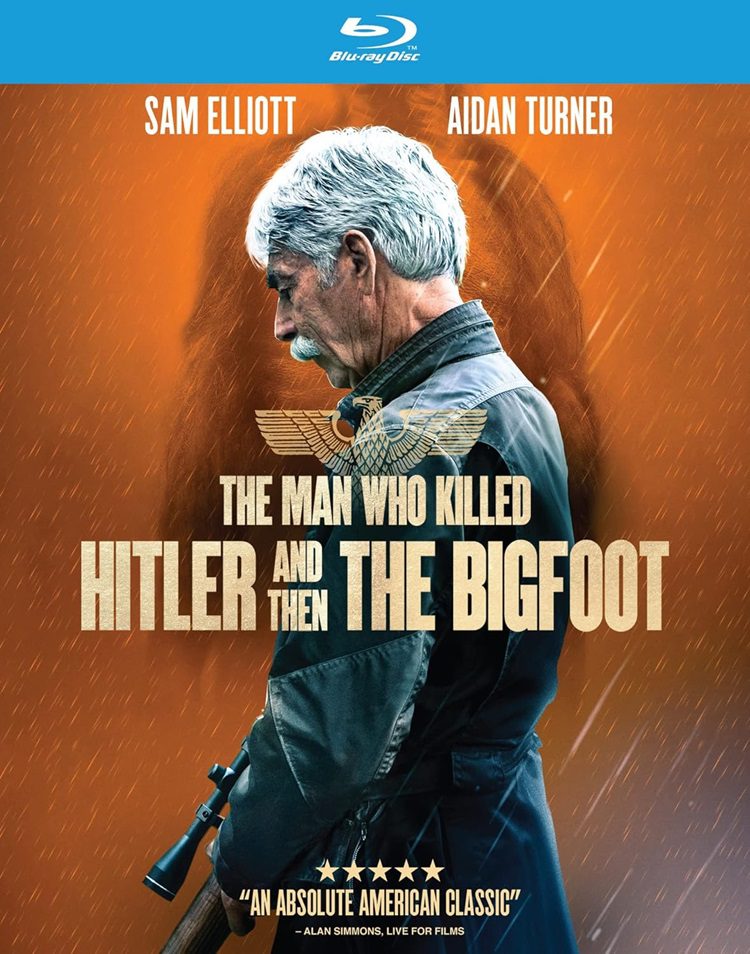
What a name for a movie! One could easily suspect The Man Who Killed Hitler and Then the Bigfoot would be the latest in grindhouse genre tributes and might be shown as a double feature with something like Hobo with a Shotgun. Alas, despite the lengthy and creative title, Robert D. Krzykowski’s debut is less of an all-out bloodfest and more of a character study on a man who once made an impact on American society – and yet few know about it.
Buy The Man Who Killed Hitler and Then the BigfootObviously, there’s quite a bit of revisionist history being put into play here, and Kryzkowski has some fun with it. The film does start off being a little too obvious, showing our main protagonist, Calvin Barr (Sam Elliott), sitting alone at a bar with a drink in front of him and Billy Squier’s “Lonely is the Night” blaring through the jukebox. Throughout the movie’s runtime, Calvin has a reflection on his life and how the events of his youth have lead him to where he is now – alone and regretful. He’s a World War II veteran whose primary mission was to take out Adolf Hitler. He was successful, but it left him with the horrible feeling that he killed another person. As Barr put it, Hitler “had it coming” and was a terrible human being, but it’s something that he, himself, didn’t like doing.
Now in his older years, Calvin’s life consists of spending time with his dog and occasionally paying a visit to his brother, Ed (Larry Miller). For someone who many would consider to be a celebrated hero, he, unfortunately, doesn’t have much going for him. Elliott, hot off his first ever Oscar nomination in his 50-year-career, gives a surprisingly emotional performance and one of his best to date. Rarely does the legendary actor get the lead role in a film, but he is in complete command here, showing us that Calvin – even in his old age – is still tough enough to single handedly take out a group of thugs 40 years younger than he is. But, deep down, he has a desire for something more. The woman he once loved, Maxine (a terrific Caitlin Fitzgerald), is long gone, and he only has the pictures and his memory of certain events to remember her by.
The flashbacks that appear throughout show a young Calvin (the perfectly cast Aidan Turner) going through with the mission. It’s a lot of build up and a little payoff, but, at the same time, the carnage of such a scene is not the film’s main focus. Kryzkowski doesn’t want viewers to think that his first feature, even though it has one of the most creative titles in film history, is one in which consistent chaos occurs. The Man Who Killed Hitler and Then the Bigfoot is more of a look at how those we consider legends are just ordinary people who may not have the most glamorous lifestyle like we think.
The film also shows us how the younger Calvin and Maxine met and fell in love. Turner and Fitzgerald have excellent chemistry together during these brief sequences, and they become more tragic when the film cuts back to its current, undisclosed timeline.
When the elder Calvin is called upon by the U.S. and Canadian governments to take out the Bigfoot, he is viewed as a hero by the one to which the movie refers as Flag Pin (Ron Livingston). The Canadian official, referred to as Maple Leaf (Rizwan Manji), is also intrigued by the war veteran’s story. Calvin assures them that he is no hero; he was just doing what he was assigned. It’s one of the film’s most powerful moments, and Elliott is tremendous when he has to reassure the men that he is not who they think he is.
The movie does fulfill its titular promise of Calvin killing the Bigfoot, but, like the Hitler mission flashback, it’s a brief moment. Elliott does get the opportunity to spout some humorous lines, such as one in which he’s disappointed by the creature’s real appearance not living up to his name. Krzykowski does also enter B-movie territory with the short sequence, and the practical effects on the Bigfoot creature are well done.
The Man Who Killed Hitler and Then the Bigfoot may not be the movie people were expecting, and, for the most part, that’s a good thing. Krzykowski does give B-movie lovers several scenes and sight gags to enjoy, and there may never be another movie that will have a title as original and as unique as this. But, at the same time, the two tones make it feel a little unbalanced. The obvious, B-movie stuff is fun, but it’s at its best when we get the more human, dramatic scenes with Elliott and those whom he comes across.
It may be more serious than silly, but Krzykowski’s film also lives up to what Calvin tells Flag Pin and Maple Leaf about his life and the mission he fulfilled. You may have heard a lot, and you may be fascinated by the story (or, in this case, movie title), but there’s more underneath the surface than you expect.